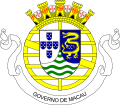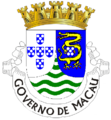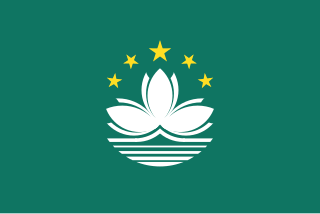
The Regional Flag of the Macau Special Administrative Region of the People's Republic of China is light green with a lotus flower above the stylised Governador Nobre de Carvalho Bridge and water in white, beneath a circular arc of five golden five-pointed stars: one large star in the center of the arc with two smaller stars on each side of the large star, each with a point angled directly outward from the center of the common circle on which they lie.

Portugal is a unitary state with delegated authority to three levels of local government that cover the entire country:

The national emblem of Cape Verde contains a circle within which is written the name of the nation in Portuguese. Within the circle are a torch and triangle, symbols of freedom and national unity. At the top of the shield is a plumbob, a symbol of righteousness; three chain links are at the bottom. This emblem replaces the earlier variant with the seashell that had been in use since independence. The current emblem was adopted in 1992.

The national emblem of Guinea-Bissau was adopted shortly after independence from Portugal in 1973.

The flag of Portugal is the national flag of the Portuguese Republic. It is a rectangular bicolour with a field divided into green on the hoist, and red on the fly. The lesser version of the national coat of arms of Portugal is centered over the colour boundary at equal distance from the upper and lower edges. Its presentation was done on 1 December 1910, after the downfall of the constitutional monarchy on 5 October 1910. However, it was only on 30 June 1911, that the official decree approving this flag as the official flag was published. This new national flag for the First Portuguese Republic, was selected by a special commission whose members included Columbano Bordalo Pinheiro, João Chagas and Abel Botelho. The conjugation of the new field color, especially the use of green, was not traditional in the Portuguese national flag's composition and represented a radical republican-inspired change that broke the bond with the former monarchical flag. Since a failed republican insurrection on 31 January 1891, red and green had been established as the colours of the Portuguese Republican Party and its associated movements, whose political prominence kept growing until it reached a culmination period following the Republican revolution of 5 October 1910. In the ensuing decades, these colours were popularly propagandised as representing the hope of the nation (green) and the blood of those who died defending it (red), to endow them with a more patriotic and dignified, therefore less political, sentiment.

The national emblem of Angola is the national emblem of Angola that reflects the recent past of the new nation. There is heavy Marxist imagery found on the device, expanded from what is found on the national flag.

The coat of arms of Brazil was created on 19 November 1889, four days after Brazil became a republic. It consists of the central emblem surrounded by coffee and tobacco branches, which were important crops in Brazil at that time. In the round shield in the center, the Southern Cross can be seen. The ring of 27 stars around it represents Brazil's 26 states and the Federal District.
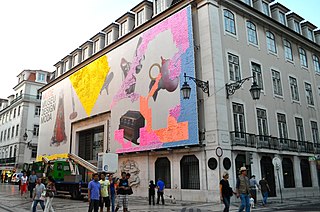
Banco Nacional Ultramarino is a Macau banking and financial services corporation. It was historically a Portuguese bank with operations throughout the world, especially in Portugal's former overseas provinces. It ceased existence as an independent legal entity in Portugal following its merger in 2001 with Caixa Geral de Depósitos, the government-owned savings bank.

The Associação de Escoteiros de Macau is the national Scouting association in Macau, China. It is an Associate Member of the Asia-Pacific Region of the World Organization of the Scout Movement, and became a Full Member of WOSM on 16 August 2017 during the 2017 World Scout Conference.

The national emblem of East Timor is one of the national symbols of East Timor.

The two Autonomous Regions of Portugal from 1999 are the Azores and Madeira. Together with Continental Portugal, they form the Portuguese Republic.
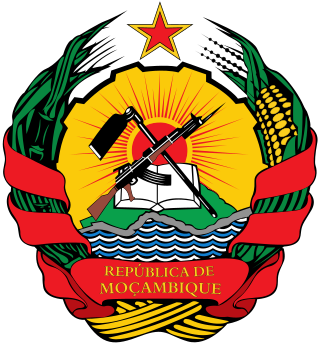
The national emblem of Mozambique was adopted in 1990 in the Constitution of Mozambique article 194. The article clearly states the design and meaning of the device. It shows a gear wheel, bordered by corn stalks and sugarcane. In the middle there is a red sun over a map of Mozambique in green, and blue waves, an AK-47 crossed with a hoe, and a book. The wreath is tied with a ribbon bearing the name of the country. The emblem is rendered in a socialist heraldry style similar to those used by the republics of the Soviet Union.

The handover of Macau from the Portuguese Republic to the People's Republic of China was at midnight on 20 December 1999. This event ended 442 years of Portuguese rule in the former settlement, which began in 1557.

The coat of arms of São Tomé and Príncipe consists of a peregrine falcon on the left and a grey parrot on the right holding a coat of arms with a palm in its center. The coat of arms is surmounted by a blue star. Above, there is a band that states the name of the country. At the base of the arms the national motto, "Unity, discipline, work" is inscribed.

The Joint Declaration on the Question of Macau, or Sino-Portuguese Joint Declaration, was a treaty between Portugal and the People's Republic of China over the status of Macau. The full name of the treaty is Joint Declaration of the Government of the Portuguese Republic and the Government of the People's Republic of China on the question of Macau. Signed on 26 March 1987, the Declaration established the process and conditions of the transfer of the territory from Portuguese rule to the People's Republic of China. The Joint Declaration served also as the main source of fundamental rights that were implemented in the Basic Law of the Macau Special Administrative Region. The process was otherwise similar to the handover of Hong Kong to Chinese sovereignty by the United Kingdom in 1997.

The coats of arms of the Portuguese Empire's colonies were all of a uniform style following 1935. Two of them had, however, been using provisional coats of arms of the same style shortly prior to this.

The Liaison Office of the Central People's Government in the Macao Special Administrative Region is the representative office of the State Council of the People's Republic of China in Macau.

Macau was a Portuguese colony from the establishment of the first official Portuguese settlement of Macau in 1557 to its handover to China in 1999. It comprised the Municipality of Macau and the Municipality of Ilhas. Macau was both the first and last European holding in China.

The symbols of Portugal are official and unofficial flags, icons or cultural expressions that are emblematic, representative or otherwise characteristic of Portugal and of its culture.

Vicente Pires is an administrative region in the Federal District in Brazil. It is bordered by Taguatinga to the west, Águas Claras to the south, Guará to the southeast, Brasília to the north, and Brazlândia to the northwest. According to a 2016 report, Vicente Pires has a population of 72,879. Vicente Pires is the 16th largest administrative region by population.






